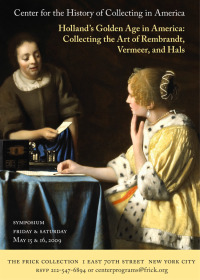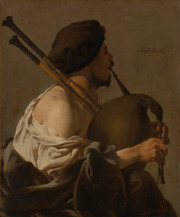Over the weekend, the Frick Collection’s Center for the History of Collecting in America put on an excellent symposium called “Holland’s Golden Age in America: Collecting the Art of Rembrandt, Vermeer and Hals.” Sounds too academic to be interesting, I know — but the fact
 that the overflow audience was filled with collectors, dealers, auction house experts and people who are just interested in art suggests otherwise. (Disclosure: Inge Reist, the Center’s director, is a friend, and as a consultant, I helped direct some funding to the Center.)
that the overflow audience was filled with collectors, dealers, auction house experts and people who are just interested in art suggests otherwise. (Disclosure: Inge Reist, the Center’s director, is a friend, and as a consultant, I helped direct some funding to the Center.)
The Center is just two years old, and was formed to address this gaping hole in art historical scholarship. Collectors, after all, are the ones who largely stock museums. The Met’s longtime curator of 20th Century art Bill Lieberman used to say he was a “collector of collectors,” not of paintings. More exhibitions — like Walter Liedtke’s “Age of Rembrandt” show in 2007 and the 2006 show of dealer-collector Ambroise Vollard, both at the Met — are likely to be organized around collectors.
The Center has already held four symposia (plus co-sponsored one in Venice on women art collectors), established fellowships for scholars, offered workshops and announced the creation of a prize, funded by Sotheby’s, for a distinguished publication on art collecting in America.
I’ve gone to sessions at a couple of the symposia (one on artists as collectors, another on “tuning points” in modern art collecting).
This one was the best so far.
In his keynote, Peter Sutton, an Old Master scholar who heads the Bruce Museum in Greenwich, Ct., said that Dutch paintings in America are so numerous (and so good) that no one can really study Dutch art without coming here. Most of them were bought after the Civil War — before then, copies were desirable. Collecting really took off in the 1880s.
It hasn’t let up much since, really. Some of today’s most prominent collectors, including Eijk and Rose-Marie van Otterloo, were in the room as Peter showed slide after slide of what Americans like Mellon, Morgan and Widener and museums like the Getty have bought.
Then, a procession of speakers took us from colonial times through today, parsing collections or telling of taste-makers like W.R. Valentiner, who was a curator at the Metropolitan Museum, headed the Detroit Institute of Arts, co-headed the Los Angeles County Museum of Art, and then took over as head of the North Carolina Museum of Art. Among his contributions were catalogues of Rembrandt in America and Hals in America. But as Dennis Weller, a curator at the North Carolina Museum, told us, Valentiner was an “expansionist,” many of whose attributions were later reversed (including by him).
Quentin Buvelot, a senior curator at the Mauritshuis, answered “Has the Great Age
 of Collecting Dutch Old Master Paintings Come to an End?” in the negative. He disputes the idea that good works are unavailable and thinks many will come on the market, deaccessioned by British stately homes or museums that don’t want them, for example. In recent years, some stolen in World War II have been restituted by museums and put on the market — like the Bagpipe Player by Hendrik Ter Brugghen recently bought by the National Gallery of Art (left).
of Collecting Dutch Old Master Paintings Come to an End?” in the negative. He disputes the idea that good works are unavailable and thinks many will come on the market, deaccessioned by British stately homes or museums that don’t want them, for example. In recent years, some stolen in World War II have been restituted by museums and put on the market — like the Bagpipe Player by Hendrik Ter Brugghen recently bought by the National Gallery of Art (left).
There was much more — and I didn’t even attend every session. You can see the entire lineup of speakers and topics here. I hope the Center will publish the papers for all to see.
Photo Credits: Frick Collection (top); National Gallery of Art (bottom).
